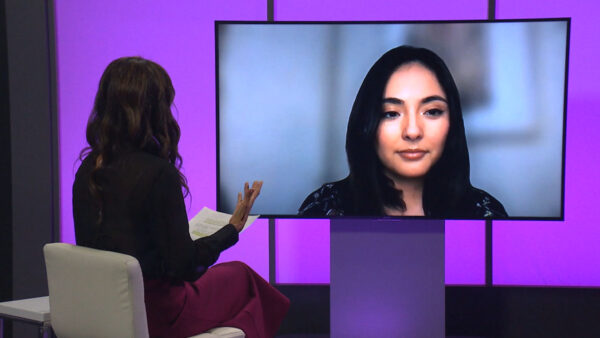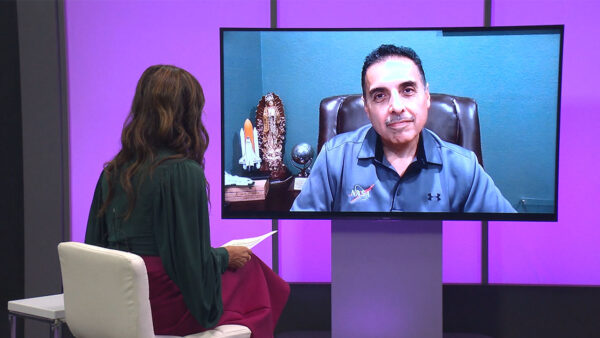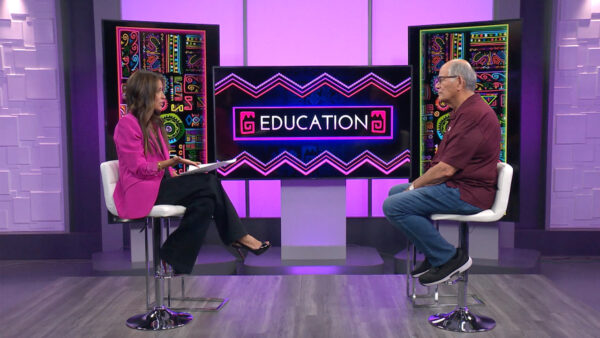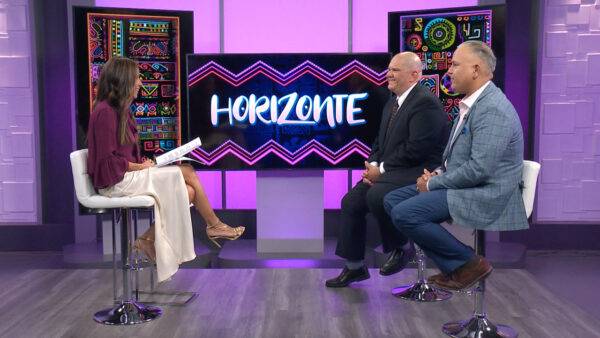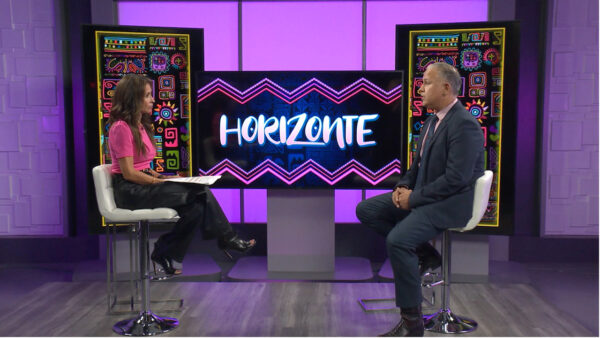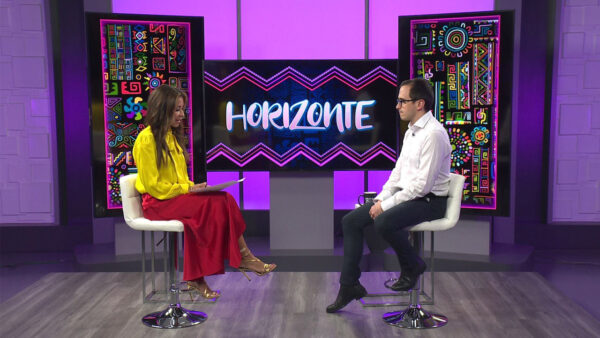Super Bowl 49 played in front of the largest national television audience in history. There were also efforts to make the big game environmentally friendly. David Farca, board member with the Arizona Super Bowl Host Committee and Jack Groh, NFL Environmental Program director talk about the environmental efforts as well as recap how Arizona did as host city.
Jose Cardenas: Good evening, I'm Jose Cardenas, a recap on the Super Bowl, we'll hear from a board member with the Arizona Super Bowl host committee. And hear how Super Bowl 49 helped to build a Green legacy in Arizona. Also get to know the first Hispanic collective to the Mesa city council, and find out about an organization providing educational resources that impacts underserved students. That's coming up next on Horizonte.
Video: Funding for Horizonte is made possible by contributions by the friends of Eight, members of your Arizona PBS station.
Thank you for joining us. Super Bowl 49 played in front of the largest TV audience in history. There were also efforts to make the game more environmentally is friendly. Joining me to talk about this and a recap of the event are David Farca, a board member with the Arizona Super Bowl host committee, and Jack Groh, environmental program director. Gentlemen, thanks for joining us on Horizonte. David, you were here a week or so ago and talking about what was coming up, and the success that we hoped the event would have. I should disclose that I was on the host committee, as well. It seems like everything went exceedingly well?
David Farca: Yes. We are very excited about how things turned out. We broke a lot of records. Attendance records. Super Bowl Central was fantastic, it gave the opportunity to a lot of people to experience the NFL without having to go to the game. Crowds were just incredible on Saturday night on Super Bowl central, and things like our social media following were through the roof. We exceeded the four previous Super Bowls combined, and social media following, so we couldn't be more pleased with the results.
Jose Cardenas: And all this despite some unusual weather for Phoenix. We had a couple of times of rain there and heavy fog on game day that went away before the game started, fortunately.
David Farca: We did a beautiful day on Sunday, sunshine. We did have a bit of rain before that. But, as we say in Arizona, it was a dry rain.
Jose Cardenas: Yeah. I want to come back and talk about the specifics. But Jack, I don't think people fully appreciate the level of effort that the NFL puts into this particularly on the environmental front, and this is something that they have been doing for, what, 20 plus years?
Jack Groh: Yeah, 22 years ago we started the environmental program, and we did it in the Georgia dome for the Super Bowl 28, and it was the first stadium in America in that had any kind of solid waste recycling, or there were not any cans or bottles recycled before that one, so it was an interesting experiment, to see if it was give us some more efficiency in our operations.
Jose Cardenas: And like everything else about the Super Bowl, it has gotten bigger and broader over time. Give us a sense for the scope of activities this year in Arizona.
Jack Groh: Well, we had a whole sweep of programs here in Arizona, in addition to solid waste recycling, which was a great effort, and we have a lot of folks from the community involved in that, too, the day after. Helping to clean up the stadium. That was a great one of a kind project. But, we've been doing food recovery for many years now where we recover prepared food from the kitchens, and it goes to soup kitchens and shelters and other organizations, and the last time we were here in Phoenix, we set a Super Bowl record of recovering 90,000 pounds of food.
Jose Cardenas: That was in 2008.
Jack Groh: Right, in 2008.
Jack Groh: And we'll find out in about a week if we, if we beat that record because we're still counting up the nonperishable food, but then we also did we are in the process now of recovering materials. We're working at the stadium, we're working downtown. All the vinyl, the fabric, the mesh, the building materials, the carpeting, all that stuff is being donated to local nonprofits. It's a terrific partnership, especially the partnership here in the Phoenix area has been one of the best that we have ever had. We have got stardust building, salvation army, treasures for teachers, and we have also got the Keep Phoenix beautiful, and all of them are working together because we are treating those four agencies. There is hardly anything that they can't find a re-purpose for, and a couple of weeks ago we did what we call our super kids, super sharing project. And that, again, was three times as big as it was last time we were here. We had 100 schools participate, and kids, after Christmas vacation, collected their used books, sports equipment, school supplies, and cell phones, and they brought them to this one big event at the croc center, salvation army center, in southeast Phoenix, and we set a goal of seeing if kids could collect 10,000 items over the course of is the program. When we got through the morning collection, kids, individual kids had brought in 33,000 items, which were then to be donated to the low income schools and youth programs throughout the area. So this is a case where one kid says gee, I got a lot, and I want to give to a kid who has less than me. And it's just it's a very heart-warming thing, and then the most recent projects we added were urban forestry, and we did that ten years ago, added urban forestry as part of the portfolio because it not only is good for the environment but leaves a Green legacy in each legacy host community. And then it is final piece of the puzzle, was what are we going to do about the energy usage at the stadium, convention center, team hotels, and so we did what we have done in past years. We negotiated a contract for renewable energy to power all those facilities for the time that we were here, and we got both local utilities, srp and aps, participated in that program, and srp took care of the stadium campus and aps took care of the downtown campus, so, there is a lot that we're trying to address, and we're trying to do it in a way in that not only lessens the environmental impact but leaves something positive behind.
Jose Cardenas: David, when you were on last, we talk about one aspect of the committee's efforts, was to emphasize our connections to Mexico, Arizona's largest training partner. How did that go?
David Farca: It was fantastic. The Pavilion in on 3rd street was really weapon received. A lot of visitors there.
Jose Cardenas: That was the visit Mexico group?
David Farca: Correct.
Jose Cardenas: And we have got some pictures we're going to put on the screen while you are talking that come from that exhibition.
David Farca: Right. It was also a Super Bowl first, to have a sponsor from a different country be part of those activities. An effort that we were really proud of, and that, also, helped bring our Hispanic local Hispanic community into the mix. We determined that Super Bowl central, we called it universal football, so it really made our community welcome, looking at their heritage, looking at that Mexico Pavilion, also made them feel like it's a different Arizona today.
Jose Cardenas: And one of the pictures that we have on the screen is of the sand sculpture, and those are some major, major landmarks in Mexico city.
David Farca: Right. And the sculptures, themselves, were brought from Mexico, and as you mentioned, with a couple of days of rain, that, basically, washed off, and they built it again, and it was an incredible talent that people really recognized out there.
Jose Cardenas: How did our visitors from Mexico feel? When people were putting this on, and the, I imagine, we had a pretty sizable tourist contingent coming from Mexico, as well?
David Farca: Yeah, we estimated that around 10 to 12,000 people coming specifically from Mexico, that was a big success, and the people that we talked to felt really welcomed. It was in the weeks leading up to the event, there was a lot of international media calling it a Super Bowl with a Latin flavor, which really made them feel welcome. I think that we should build on this for other Super Bowls because as a host committee, we were able to raise a significant amount of funds from that market that really helped put together the event. And I think that building upon that will just benefit in future Super Bowls.
Jose Cardenas: Jack, one of the major environmental initiatives that you all had was tree planting, and we have a couple of pictures that we want to show about that. Give us some of those details.
Jack Groh: Well, we put together a grant program this year, and we had three pots of money to work with. The NFL put up some funding, and Verizon, which is the first sustainability sponsor of Super Bowl. Verizon has been activating with us for two years now, and then the host committee so we put those funds together and started with a fund where we could go out to local communities, and ask them for proposals, and we would match their money that they put into the trees, and we were able to do five projects already, and they were beautiful projects. We did them in two in Phoenix, and we did Mesa, glendale, and we just had a great time with it, and folks really enjoyed it because it was is a project that the community, themselves, wanted to do, so we weren't coming in and saying we want to plant trees in your community. We came in and said where would you like to plant trees in your community, and we will help you do that. And we're going to have a couple more in the spring, too.
Jose Cardenas: And I understand one of the most successful projects was in Glendale, itself?
Jack Groh: Yeah, that was a terrific project. That was at saguaro ranch, and they provide citrus fruit, about 50 tons of fruit gets harvested each year, and it goes to st. mary's food bank. That was the first food bank in America, very historic organization. So we went out and we replaced about three dozen of their older trees that were diseased or had died, and while we were out there, we had a couple hundred volunteers picking fruit, and we had pro bowl cheerleaders out there picking grapefruit, so it was a lot of fun. It was very colorful.
Jose Cardenas: And I understand it's not easy to put a dollar value on this, but there are some estimates as to the impact of the environmental initiatives, and what would you say about this year's Super Bowl in that regard?
Jack Groh: The total return on investment from our projects has increased dramatically over the years. And this year was if not the highest, at least one of the highest returns on investment, and the way we measure that is we look at one figure, which is how much did the NFL benefit financially from it? Did we cut our ways hauling bills, did we reduce the cost of the event Production? That's a minor part of it. The big part of the return on investments was is how much did we invest into the community? So, all the materials that are being brought down and donated, there is more than half a million dollars of raw materials there that are being donated to various nonprofits. The food, we don't know the value yet but last time we were here, the food bank estimated that about 150,000 worth of food was recovered from events, and then donated, so we start to add all this stuff up, and there is a huge return on our investment, that goes to the local community, and some folks might say well, return on investment, shouldn't you be getting the money? We are getting the value from my opinion on this, we're getting the value of being a good guest in the community, while doing something of value in the community, and all that can do is just build the brand of Super Bowl and build the brand of the NFL, as we go forward.
Jose Cardenas: And David, speaking of building on the success of the Super Bowl, there will be a lot of information about the economic impact, the immediate economic impact, but there were a number of things you touched on, one of them, the designs going into the future, so this is kind of a wrap-up. Let's talk about that.
David Farca: Yeah, that came from the idea that we had a couple of CEOs back in 2008 in the Super Bowl. They came on their own. That's how they got to see Arizona, and they made large investments in the valley. So, taking that as an empirical situation and turning it into a real program, we came up with a CEO program. So, during this week we hosted about 65 CEOs from not only around the country, but around the world, and showcasing Arizona, what Arizona offers. It was a chair leader, by our Governor, Governor Ducey, so we had a great panel on Friday morning. We had different activities for them to really know what Arizona has to offer from a business perspective. So, the economic impact that we have this week is one part of it, but we think that we will have a longer term economic impact because of programs like our CEO.
Jose Cardenas: So Seattle Seahawks' fans may be disappointed. Thank you both for joining us on Horizonte.
David Farca: Thank you for having us.
Jack Groh: Thanks.
David Farca:Board Member, Arizona Super Bowl Host Committee; Jack Groh:Director, NFL Environmental Program;








